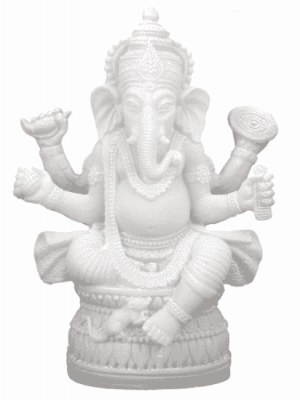Ganesha is the son of the goddess Parvati and Shiva, one of the most important and worshiped gods. But why is Ganesh important to Hinduism, and why is he so beloved? Here we’ll tell you everything about the meaning of the Hindu god Ganesh!
Ganesha is the Hindu god of wisdom and knowledge. Other names for him include Ganesh and Ganapati Tantra, but he is often also recognized as the Hindu elephant god. Ganesha is loving, kind, and polite, so it shouldn’t be surprising that he is one of the most popular Hindu Gods! But exactly who is Ganesh, why does he have an elephant’s head, and why is he riding a rat? You will discover it all in our Ganesh blog!
The Ganesha Story
The story of Ganesha begins when his mother Parvati formed him from the dust of her own body. She then breathed life into him and asked him to protect her. She told Ganesha to guard the gate because her husband Shiva was away from home. Little Ganesha was not allowed to let any stranger in. “If you have to, use force,” she told him. When Shiva finally appeared at the gate, he and his son Ganesha did not recognize each other. Thinking Shiva was a stranger, the faithful young god would not let him enter the home, angering Shiva who beheaded him. Parvati saw this and after revealing that Ganesh was their son, ordered her husband to find him a new head. Shiva, filled with remorse did so and returning with an elephant head, revived Ganesha.
Ganesh the Hindu Elephant God Meaning
Many Hindus pray to Ganesha when they start something new, such as a new job, starting a business, or when they move. Praying to Ganesh is thought to remove obstacles or help you to overcome them. Also, Ganesha is thought to protect you when you travel. You often see the elephant god at the entrance of houses, along the side of the road, and at T-junctions.
Ganesh can Help!
Besides being able to help you clear and remove obstacles from your path, Ganesha is also thought to bring you success and happiness. He may even help you to be brave enough to say “yes” to your heart’s desires and do what you love. When starting a new project or business, he may help you bring you success!
Symbolism:
Including Ganesh, Indian Gods are often represented with important symbolic attributes. It’s not just his elephant’s head either! From his tusks to his dancing toes, statues of Ganesha are full of important symbols that immediately answer the question “what is Ganesh the God of?” and reveal his playful personality.
Ganesha Riding a Mouse or Rat
Elephants afraid of mice? Not Ganesha! The favorite transportation of this Indian elephant god is a mouse or rat, called Mashika. Even though it may look comical, Ganesh riding a rat is meant to send a message. According to tradition, the rat is symbolic of the gnawing ego. Elephants are widely associated with intelligence and wisdom in Asian cultures, so it shouldn’t be surprising that with his elephant head, Ganesh is the Hindu god of Wisdom. Therefore riding a rat is symbolic of Ganesha taming his ego with reason, something we could all learn from!
Dancing Ganesha
Dancing is an important spiritual activity and Ganesh is a natural! In Hindu culture dance represents the perpetual cycle of creation and destruction associated with Ganesh’s father Shiva. According to legend, Ganesha regularly entertained his parents by playing an instrument or dancing the ‘Ananda Tandava,’ Shiva’s cosmic dance. Ganesha’s plump body joyfully swinging to this dance of cosmic power is a reminder that despite his cheerful and kind personality, he is nevertheless a powerful deity. Many dancers pay tribute to Ganesh before taking the stage so that they can ensure a great performance.
Ganesha’s Fat Belly
Ganesha is often depicted with a big belly, which is of course also symbolic. His big bare belly stands for the cosmos, for all seven kingdoms above, below and the seven oceans. When a snake wraps around this, it holds the cosmic energy in Ganesh’s belly together. Other versions of Ganesh’s story tell that his big belly represents generosity and acceptance.
Do you also want a Ganesha in your house? There are many types of Ganesha statues available.
Check Out Our Assortment of Ganesha Statues
More Ganesh Symbols
In addition to his characteristic appearance, Ganesh appears with different symbols:
- Ohm Sign
- Raised Hand
- Upward Turned Palm
- Broken Tusk
- Axe or Hatchet
- Lasso or Rope
- Lotus Flower
- Sweets
- Crown
Ohm Sign
Between his eyes and above his trunk, Ganesh often wears the Ohm sign. Ohm is the sound from which the universe originated. During meditations the ohm sound can help you experience how powerful the cosmos is.
Raised Hand
Ganesha’s raised hand represents protection. He’s saying something like, “Don’t be afraid, I’m with you.” This blessing pose shows that the wise god is always watching his devotees.
Upturned Palm
Ganesha’s lower left hand is usually open, palm up. This is symbolic of his endless giving and kindness. It is also an invitation for his followers to bow to the knowledge that everything will one day return to from where it came.
Broken Tusk
The broken tusk is a reminder to care for the good in us and to distance ourselves from the bad or like the broken tusk, that which no longer serves us. It also stands for wisdom and emotion, with the broken left tusk meaning that you must let wisdom take control of emotions.
Ax or Hatchet
Often Ganesh holds an ax or hatchet in his top right hand. This is the weapon he uses to loosen all bindings. You could compare this a bit with Archangel Michael, who cuts negative bonds with his sword. Ganesh stands ready to cut you free from what is holding you back.
Lasso or Rope
The god’s rope or lasso symbolizes controlling the mind and thoughts. It is discipline and wisdom.
Lotus Flower
The Lotus flower grows to the light at the surface from a dark and unclean swampy bottom. An open lotus flower symbolizes purity, clarity, a state of enlightenment, and the expansion of the soul.
Sweets
Ganesha loves good food and really has a sweet tooth, or rather sweet tusk. Sometimes he is depicted with a bowl of sweets, usually a bowl of Laddus. This sweet snack symbolizes the sweet reward you receive for traveling the path of enlightenment while also showing the wealth, prosperity, and spiritual knowledge that Ganesh bestows on his devotees.
Crown
The richly decorated crown on the head symbolizes the divine. Behind this crown you see a wreath of fire (agni), which represents the cycle of destruction and rebirth.
Ganesh Chaturthi
Ganesh Chaturthi is a festival in August or September that celebrates the birth of the god. On the first day, a new statue of Ganesha is bought and placed on an altar at home. In order to let the power of the god pass into the image, offerings such as flowers, sweets and certain dishes are made. During the feast, which can last up to ten days, the statue remains on the altar. On the last day, the families throw the statue into the water of the nearest river, lake or sea.
Now that we have answered you’re biggest Ganesh questions, it’s time for you to discover his cheerful protective power for yourself! Incorporate a dancing Ganesh into your yoga space or place him seated by the door to clear your path each day. Or maybe include him into your energy work. There are plenty of crystals associated with him like, Hematite, Smoky Quartz, Obsidian, and Black Tourmaline. You guessed it, protective stones!
For wisdom and a wide open road, get to know Ganesh!

















 Nederland
Nederland
 België
België
 Deutschland
Deutschland
 Europe
Europe
 España
España
 Sverige
Sverige
 Français
Français